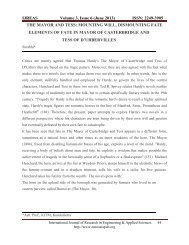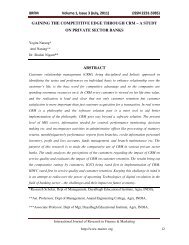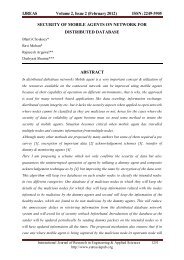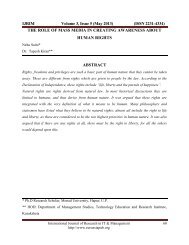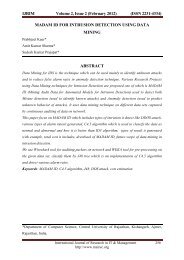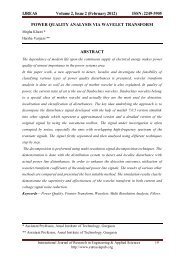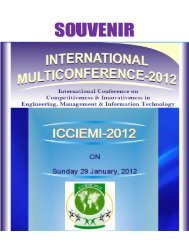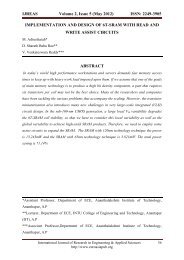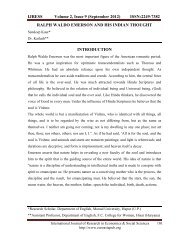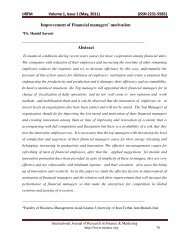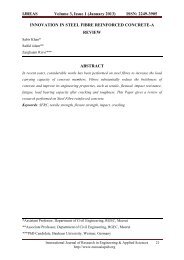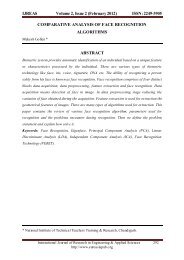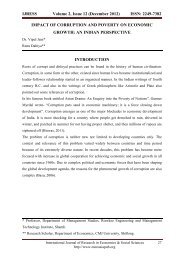establishment of the relationship between ... - Euroasiapub.org
establishment of the relationship between ... - Euroasiapub.org
establishment of the relationship between ... - Euroasiapub.org
- No tags were found...
Create successful ePaper yourself
Turn your PDF publications into a flip-book with our unique Google optimized e-Paper software.
IJRESS Volume 2, Issue 3 (March 2012) ISSN: 2249-7382ESTABLISHMENT OF THE RELATIONSHIP BETWEENORGANIZATIONAL DEVELOPMENT AND ORGANIZATIONALEFFECTIVENESS (A CASE STUDY OF S.K.G. REFRACTORIES LTD.-NAGPUR MARKETING OFFICE)Rumi Dasgupta*INTRODUCTIONOrganization Development (OD) is a process by which behavioural science knowledge andpractices are used to help <strong>org</strong>anizations to achieve greater effectiveness, including improvedquality <strong>of</strong> life, increased productivity, and improved product and service quality. Its focus ison improving <strong>the</strong> <strong>org</strong>anization's ability to assess and to solve its own problems. Moreover,OD is oriented to improving <strong>the</strong> total system - <strong>the</strong> <strong>org</strong>anization and its parts in <strong>the</strong> context <strong>of</strong><strong>the</strong> larger environment that impacts upon <strong>the</strong>m.Stoner (HR Management researcher) points out that OD is not designed to solve a single ortemporary problem in <strong>the</strong> <strong>org</strong>anization. Its intention is to move <strong>the</strong> <strong>org</strong>anization to a higherlevel <strong>of</strong> functioning - that is, to improve <strong>the</strong> performance and satisfaction <strong>of</strong> <strong>org</strong>anizationmembers.As it is possible to see in <strong>the</strong> next section, OD has experienced major changes through time;for that reason it is difficult to arrive at a clear and definitive definition <strong>of</strong> OD. Never<strong>the</strong>less,it is important to point out that OD is a managerial <strong>the</strong>ory whose focus is satisfaction <strong>of</strong> bothpeople and <strong>org</strong>anizations. In addition, OD techniques are useful in any situation, butespecially when a change occurs in <strong>the</strong> <strong>org</strong>anization. The term ‘Organizational Development’is <strong>of</strong>ten used interchangeably with ‘Organizational Effectiveness’ (OE), especially when usedas <strong>the</strong> name <strong>of</strong> a department or a part <strong>of</strong> <strong>the</strong> Human Resources function within an<strong>org</strong>anization. Organizational effectiveness is <strong>the</strong> concept <strong>of</strong> how effective an <strong>org</strong>anization isin achieving <strong>the</strong> outcomes <strong>the</strong> <strong>org</strong>anization intends to produce. Organizational effectivenessis determined by <strong>the</strong> degree to which it attains its objectives.*Research Scholar, Nagpur University.International Journal <strong>of</strong> Research in Economics & Social Sciences 38http://www.euroasiapub.<strong>org</strong>
IJRESS Volume 2, Issue 3 (March 2012) ISSN: 2249-7382OBJECTIVE OF THE STUDYThe objective <strong>of</strong> <strong>the</strong> study is to analyze <strong>the</strong> concept <strong>of</strong> Organizational Development and itsrelevance in <strong>the</strong> process <strong>of</strong> attaining Effectiveness <strong>of</strong> <strong>the</strong> <strong>org</strong>anization and to establish a<strong>relationship</strong> <strong>between</strong> OD & OE in relation to a particular case study in an <strong>org</strong>anizationdealing with refractory products.This case study can be related to any industry for a similar or partly similar situation. It isfocused on <strong>the</strong> adaptation <strong>of</strong> new sales and marketing strategies.LIMITATIONSThe limitations <strong>of</strong> this research study are that, it is focused on a particular case study <strong>of</strong> an<strong>org</strong>anization and <strong>the</strong> data were collected through <strong>the</strong> concerned managers <strong>of</strong> <strong>the</strong> same. It wasnot a field work by <strong>the</strong> researcher. So, <strong>the</strong> dependence on collected data was a compulsion.PLACE :- SKG REFRACTORIES LTD,214, JP CHAMBER,SOUTH AMBAZARI ROAD,NAGPUR-440010METHODOLOGYThe first category <strong>of</strong> sample consisted <strong>of</strong> nine (9) middle management staff (General-.Manager, Managers, Deputy and Assistant Managers etc.) those were directly related to <strong>the</strong>marketing and sales <strong>of</strong> <strong>the</strong> products. Their aptitude score before and after a ‘skilldevelopment program’ by H.R.D. department were collected and analyzed by statisticaltechniques; interpretation was drawn.The second category <strong>of</strong> sample were 54 sales data (in Tons) which were sold to customersover a period <strong>of</strong> 9 months (Jan 2009 to Sept. 2009). These sales data (after <strong>the</strong> conduction <strong>of</strong>sales campaign) were analyzed and interpreted by statistical techniques.The third category <strong>of</strong> sample were 18 sales data (in tons) over a period <strong>of</strong> three months Oct.2009 to Dec. 2009. These data were tested by statistical techniques after providing somecoordination and indirect incentives to <strong>the</strong> client <strong>org</strong>anizations.PROCEDURE & RESULTSProcedureIt started with keeping permission from <strong>the</strong> authorities concerned <strong>of</strong> SKG Refractories Ltd.Marketing <strong>of</strong>fice, Nagpur, to involve managers <strong>of</strong> <strong>the</strong>ir industry for <strong>the</strong> research study. Afterfixing a particular date by prior appointment, <strong>the</strong> G.M. (Marketing) provided <strong>the</strong> datarequired for pursuing <strong>the</strong> research study. All <strong>the</strong> relevant data required to conduct <strong>the</strong>International Journal <strong>of</strong> Research in Economics & Social Sciences 39http://www.euroasiapub.<strong>org</strong>
IJRESS Volume 2, Issue 3 (March 2012) ISSN: 2249-7382research study were collected, analyzed and interpretations were drawn by <strong>the</strong> results <strong>of</strong>statistical calculations.ResultsA) To improve <strong>the</strong> sales <strong>of</strong> <strong>the</strong> special refractory products A, B, C, D, E & F, special skilldevelopment program in sales and marketing was conducted and 9 managerial staff tookpart in that.The aptitude score <strong>of</strong> <strong>the</strong> employees before and after <strong>the</strong> program were noted as follows:Participants 1 2 3 4 5 6 7 8 9Score before <strong>the</strong> program 46 45 49 43 44 46 48 44 45Score after <strong>the</strong> program 48 47 48 45 43 45 50 47 44Let us suppose <strong>the</strong> score before <strong>the</strong> program as ‘x’ and that after <strong>the</strong> program ‘y’. we take <strong>the</strong>null hypo<strong>the</strong>sis that <strong>the</strong> mean <strong>of</strong> <strong>the</strong> difference is zero, we can write:H O : µ 1 = µ 2 which is equivalent to test H O : D = 0H O : µ 1
IJRESS Volume 2, Issue 3 (March 2012) ISSN: 2249-7382Standard deviation <strong>of</strong> differences∂ diff. =∑D 2 i−− (D) xnn −1=229 − ( −0.778)9= 1.7159 −1t =−D−0 − 0.778 − 0= = -1.361∂ / n 1.715/ 9diffDegrees <strong>of</strong> freedom = n – 1 = 9 – 1 = 8.As H a is one sided, we apply one-tailed test (in <strong>the</strong> left tail as H a is <strong>of</strong> less than type) fordetermining <strong>the</strong> rejection region at 5% level <strong>of</strong> significance which comes to as under using<strong>the</strong> table <strong>of</strong> ‘t’ distribution <strong>of</strong> 8 degrees <strong>of</strong> freedom:R:t < - 1.860The observed value <strong>of</strong> t = -1.361Which is it <strong>the</strong> acceptance region so we accept H 0 and can conclude that difference <strong>between</strong><strong>the</strong> scores before and after <strong>the</strong> developmental programme is insignificant.Hence we can conclude that, <strong>the</strong> programme was not effective.B) Typical sales data (in MT) from January 2009 to Sept. 2009 are furnished below.After <strong>the</strong> sales campaign programme, <strong>the</strong> sales increased. The decline in sales is clear in May2009 and June 2009, from July 2009 onwards it took <strong>the</strong> desired shape.Sales in 2009(MT)Prod Jan Feb Mar Apr May Jun Jul Aug SeptABCDEF8946517866829044.5538064788845528165849244557967828339487161798540466963758838457465799042.547776980894146807081Average <strong>of</strong> sales <strong>of</strong> in <strong>the</strong> month <strong>of</strong> Jan, Feb, March, April 2009International Journal <strong>of</strong> Research in Economics & Social Sciences 41http://www.euroasiapub.<strong>org</strong>
IJRESS Volume 2, Issue 3 (March 2012) ISSN: 2249-7382ProductsASales in MT89 + 90 + 88 + 924= 89.75B46 + 44.5 + 45 + 444= 44.875CDEF51+53 + 52 + 55478 + 80 + 81+79466 + 64 + 65 + 67482 + 78 + 84 + 824= 52.75= 79.5= 65.5= 81.5Average <strong>of</strong> sales <strong>of</strong> individual product in May & June 2009 (decline)ProductsASales in MT83 + 85= 842BCD39 + 40248 + 46271+692= 39.5= 47= 70E61+63= 622F79 + 752= 77International Journal <strong>of</strong> Research in Economics & Social Sciences 42http://www.euroasiapub.<strong>org</strong>
IJRESS Volume 2, Issue 3 (March 2012) ISSN: 2249-7382Average <strong>of</strong> sales individual product in <strong>the</strong> months July, Aug & Sept. 2009 (increase)ProductsSales in MTABCDEF88 + 90 + 89= 89338 + 42.5 + 41= 40.5345 + 47 + 46= 46274 + 71+80= 77365 + 69 + 70== 68379 + 80 + 81= 803Let us suppose <strong>the</strong> sales (in tons) before and after <strong>the</strong> extensive promotional campaignprogram are ‘x’ and ‘y’ respectively.The null hypo<strong>the</strong>sis is <strong>the</strong> sales were not improved after <strong>the</strong> campaign.H O : µ 1 = µ 2 (eqvt. To test H 0 : D = 0)H a : µ 1 < µ 2 (campaign has been a success)t =−D−0∂ diff/ nSales after Diff. D i = x ii -Products Sales beforecamp. X ii camp. Y ii y iiA8489-5B39.540.5-1C4746+1D7077-7E6268-6F7780-3Diff. sqr. D i251149369ΣD i =-21 ΣD i 2 =121International Journal <strong>of</strong> Research in Economics & Social Sciences 43http://www.euroasiapub.<strong>org</strong>
IJRESS Volume 2, Issue 3 (March 2012) ISSN: 2249-7382∑D i21D = = − = −3.5n 6∂ diff. =∑−2D − (D)in −12n=121−( −3.5)6 −1− 3.5− 0t = = -2.7483.08/ 62x6= 3.08Degrees <strong>of</strong> freedom = (n-1) = 6-1 = 5.H 0 is one sided, a one-tailed test is applied in <strong>the</strong> left tail as H a is less than one type. Fordetermining <strong>the</strong> rejection region at 5% level <strong>of</strong> significance which comes to as under, usingtable <strong>of</strong> t distribution for 5 d.f.R: t < -2.015.The observed value <strong>of</strong> t is -2.784 which falls in <strong>the</strong> rejection region and thus we reject H o at5% level and conclude that sales promotional campaigning program has been a success.In <strong>the</strong> 1 st week <strong>of</strong> Sept. 2009, as proposed by HRD ano<strong>the</strong>r attempt (described below) wastaken by <strong>the</strong> Company for fur<strong>the</strong>r sales growth <strong>of</strong> <strong>the</strong> aforesaid products.Free services by way <strong>of</strong> deputation <strong>of</strong> application engineers were <strong>of</strong>fered by <strong>the</strong> company to<strong>the</strong> customers who were for first time, using <strong>the</strong>se products or who needed applicationguidance during shutdown jobs.This drive <strong>of</strong> providing solutions (not only selling products) indeed helped <strong>the</strong> <strong>org</strong>anization toearn <strong>the</strong> customers confidence.This was an indirect incentive to <strong>the</strong> client <strong>org</strong>anizations. After this declaration, <strong>the</strong> sales <strong>of</strong><strong>the</strong> months <strong>of</strong> October, November and December 2009 were analyzed and <strong>the</strong> mean wascalculated.International Journal <strong>of</strong> Research in Economics & Social Sciences 44http://www.euroasiapub.<strong>org</strong>
IJRESS Volume 2, Issue 3 (March 2012) ISSN: 2249-7382The table is given belowProductsABCDEFSales (in MT)October 2009 November 2009 December 200991454970698492435169.57285Mean <strong>of</strong> sales for <strong>the</strong> above months <strong>of</strong> <strong>the</strong> products (in tons)91 + 93 + 93A == 92345 + 43 + 44B == 44349 + 51+52C == 50.667370 + 69.5 + 75D == 71.5369 + 72 + 73E == 71.333384 + 85 + 84.5F == 84.53934452757384.5Let us suppose <strong>the</strong> sales (in tons) before and after <strong>the</strong> declaration <strong>of</strong> <strong>the</strong> incentives are x & yrespectively.The null hypo<strong>the</strong>sis is <strong>the</strong> sales were not improved after <strong>the</strong> announcement <strong>of</strong> <strong>the</strong> incentive<strong>of</strong>fer.H 0 : µ 1 = µ 2 (equivalent to test H 0 : D =0)H a : µ 1 < µ 2 (announcement <strong>of</strong> incentives has been a success)t =−D−0/ n∂ diff .International Journal <strong>of</strong> Research in Economics & Social Sciences 45http://www.euroasiapub.<strong>org</strong>
IJRESS Volume 2, Issue 3 (March 2012) ISSN: 2249-7382Calculation for ‘t’Products Sales before<strong>the</strong> declaration<strong>of</strong> <strong>the</strong>incentives to<strong>the</strong> client<strong>org</strong>naizations2Diff. D i = x iii - Diff. sqr. D i Sales after <strong>the</strong>y iiideclaration <strong>of</strong><strong>the</strong> incentivesto <strong>the</strong> client<strong>org</strong>naizationsy iiix iiiA89B40.5C46D77E68F80∑D i13.5D = = − = −2.25n 6924450.66771.571.33384.5-39-3.512.25-4.667 21.78+5.530.25-3.333 11.089-4.520.25ΣD i =--13.5 ΣD 2 i =104.619∂ diff. =∑−2D − (D)nin −1=104.619−(−2.25)6 −126=74.244= 3.8535t =−D−0∂ diff/ n=− 2.25− 03.853/ 6− 2.25= =−1.43031.573Degrees <strong>of</strong> freedom = (n-1) = 6-1 = 5H 0 is one sided, a one tailed test is applied at <strong>the</strong> left tail as H a is less than one type. Fordetermining <strong>the</strong> rejection region at 5% level <strong>of</strong> significance which comes to as under, using<strong>the</strong> table <strong>of</strong> t distribution for 5 degrees <strong>of</strong> freedomR : t < -2.015The observed value <strong>of</strong> ‘t’ is -1.4303 which falls in <strong>the</strong> rejection region so we reject H o at 5%level <strong>of</strong> significance and accept H a ; it can be concluded that <strong>the</strong> incentives to <strong>the</strong> customers orclient <strong>org</strong>anizations has been a success.International Journal <strong>of</strong> Research in Economics & Social Sciences 46http://www.euroasiapub.<strong>org</strong>
IJRESS Volume 2, Issue 3 (March 2012) ISSN: 2249-7382CONCLUSIONIn this research study, to increase <strong>the</strong> decreased sales was <strong>the</strong> <strong>org</strong>anizational effectiveness(partly), which helped <strong>the</strong> <strong>org</strong>anization to achieve its sales target (goal) and <strong>the</strong> <strong>org</strong>anizationaldevelopment interventions (apart from interventions from o<strong>the</strong>r areas) were (A) Marketingand Sales Development approach towards <strong>the</strong> key persons (9 managerial staff in this case)(B) Specially Designed, Extensive Sales Promotional Campaign and (C) Incentives andemployees to <strong>the</strong> customers to sustain sales growth.It has been proved by several Hypo<strong>the</strong>ses that, out <strong>of</strong> <strong>the</strong>se three OD efforts, ‘skilldevelopment program’ <strong>of</strong> <strong>the</strong> required executives was not successful, but, ‘salespromotional campaign’ and ‘incentives to <strong>the</strong> customers’ were effective and yielded <strong>the</strong>desired results (target/ objective/ goal).INTERPRETATIONBusinessGrowthORG.EFFECTIVENESSIncrease <strong>of</strong> declined sales <strong>of</strong>some products and also fur<strong>the</strong>rsales growth <strong>of</strong> <strong>the</strong> products.(Short term Goal/ Objective)1)Development <strong>of</strong><strong>the</strong> key persons inthis areaThis intervention did notwork .ODINTERVENTION3) Incentives to <strong>the</strong>client-<strong>org</strong>anization.This approach yieldedfur<strong>the</strong>r increase in sales.2) Extensive salespromotional campaignspecially designed byH.R. expertsThis approach brought<strong>the</strong> desired target.International Journal <strong>of</strong> Research in Economics & Social Sciences 47http://www.euroasiapub.<strong>org</strong>
IJRESS Volume 2, Issue 3 (March 2012) ISSN: 2249-7382Hence, properly designed OD intervention for any particular unwanted situation canbring OE. So, it can be concluded that proper OD process (or processes) is directlyproportional to <strong>the</strong> desired OE in a business <strong>org</strong>anization and it enhances <strong>the</strong> businessgrowth.REFERENCESBooks:1. Ackroyd S. Crowdy P.A. 91990). ‘CAN CULTURE BE MANAGED’ PersonnelReview, New York.2. Adams J.L. (1987). ‘CON CEPTUAL BLOCK BUSTING’ Penguine. U.S.A.3. Branes, B. (1996). ‘MANAGING CHANGE’ Pitman, New York.4. Blair, G. & Mendows, S. (1996). ‘THE REAL LIFE GUIDE TOORGANISATIONAL CHANGE’ Grower, India.5. Gordon, Judith. R. (1996). ‘ORGANISATIONAL BEHAVIOUR’. Prentice Hall,New Jersey.6. Kanter R.M. (1989). ‘WHEN GIANTS LEARN TO DANCE’. Unwin. London.7. Mintzberg, H. (1989). ‘MINTZBERG ON MANAGEMENT’ Free Space, New York.8. Senge P. (1995). ‘THE FIFTH DISCIPLINE FIELDBOOK’. Brearly. London.9. T.N. Chhabra (2000). ‘HUMAN RESOURCE MANAGEMENT: CONCEPTS ANDISSUES’. Dhanpat Rai. Delhi.10. Uday Pareek (1994). ‘MAKING ORGANISATIOAL ROLES EFFECTIVE’. TataMcGraw Hill. New Delhi.11. Wilson, D. (1992). ‘A STRATEGY OF CHANGE’ Routledge, London.12. William Scott Mackey (1983). ‘RELATIONSHIP BETWEEN CONSENSUS ONCRITERIA OF EFFECTIVENESS AND RATINGS OF EFFECTIVENESS’Lincoln.Journals1. Indian Management (<strong>the</strong> journal <strong>of</strong> A.I.M.A.) Volume-45, Issue-3, March 2006, p. 61,p. 71-76.2. Indian Management (<strong>the</strong> journal <strong>of</strong> A.I.M.A) Volume-45, issue-4, April 2006, p. 10-14.Websitewww.BPOIndia.<strong>org</strong>www.wikipedia.<strong>org</strong>International Journal <strong>of</strong> Research in Economics & Social Sciences 48http://www.euroasiapub.<strong>org</strong>



